CHEVROLET VEGA 1976 1.G Manual PDF
Manufacturer: CHEVROLET, Model Year: 1976, Model line: VEGA, Model: CHEVROLET VEGA 1976 1.GPages: 87, PDF Size: 32.36 MB
Page 71 of 87
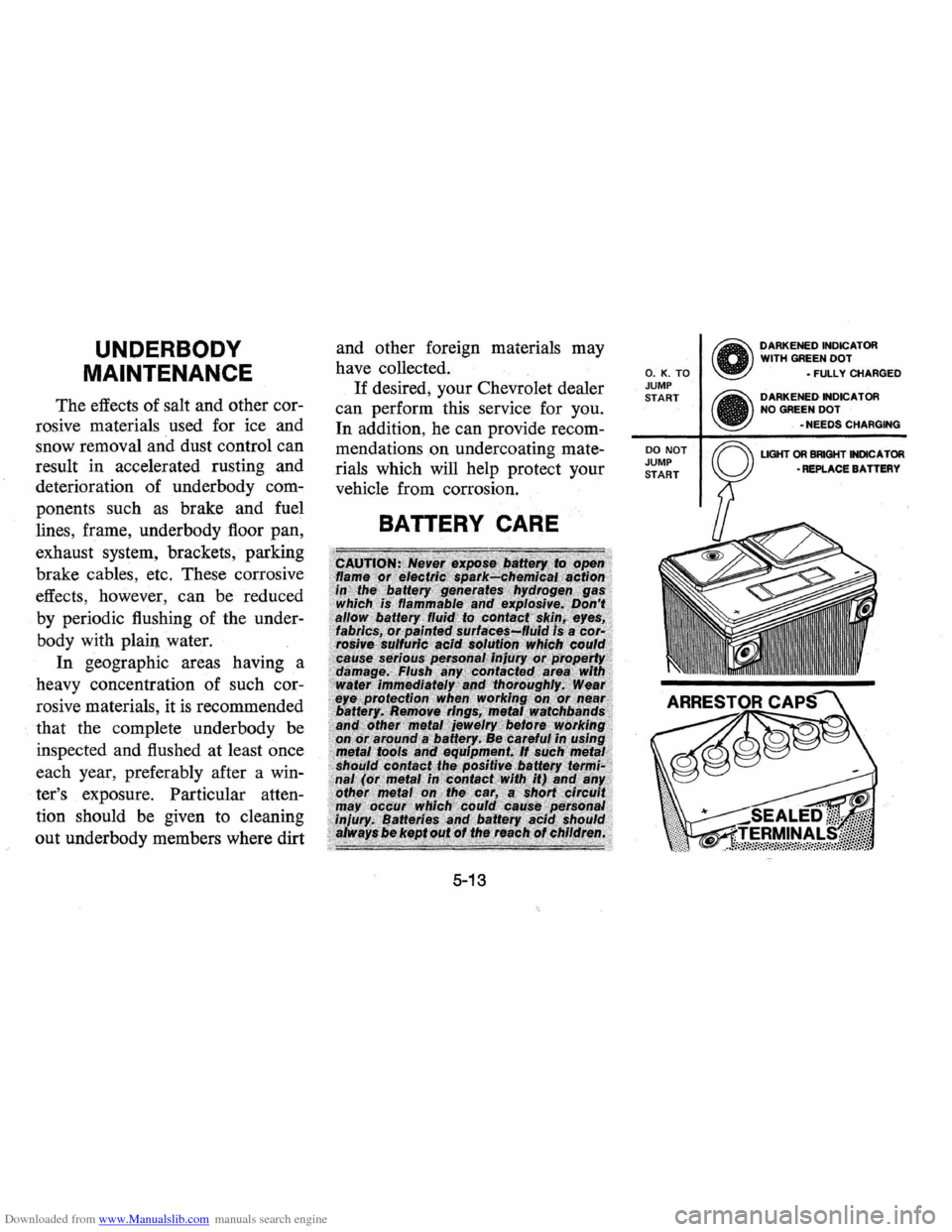
Downloaded from www.Manualslib.com manuals search engine UNDERBODY
MAINTENANCE
The effects of salt and other cor
rosive materials used for ice and
snow removal and dust control can
result in accelerated rusting and
deterioration of underbody com
ponents such
as brake and fuel
lines, frame, underbody floor pan,
exhaust system, brackets, parking
brake cables, etc. These corrosive
effects, however, can be reduced
by periodic flushing of the under
body with plain water.
In geographic areas having a
heavy concentration of such cor
rosive materials, it
is recommended
that the complete underbody be
inspected and flushed at least once
each year, preferably after a win
ter's exposure. Particular atten
tion should
be given to cleaning
out underbody members where dirt and
other foreign materials may
have collected.
If desired, your Chevrolet dealer
can perform this service for you.
In addition ,
he can provide recom
mendations
on undercoating mate
rials which will help protect your
vehicle from corrosion.
BATTERY CARE
5-13
O. K. TO JUMP START
DO NOT JUMP START
o DARKENED .... DICATOR
WITH GREEN DOT
• FULLY CHARGED
•. 11 DARKENED .... DICATOR NO GREEN DOT
• NEEDS CHARGING
•
REPLACE BATTERY
Page 72 of 87
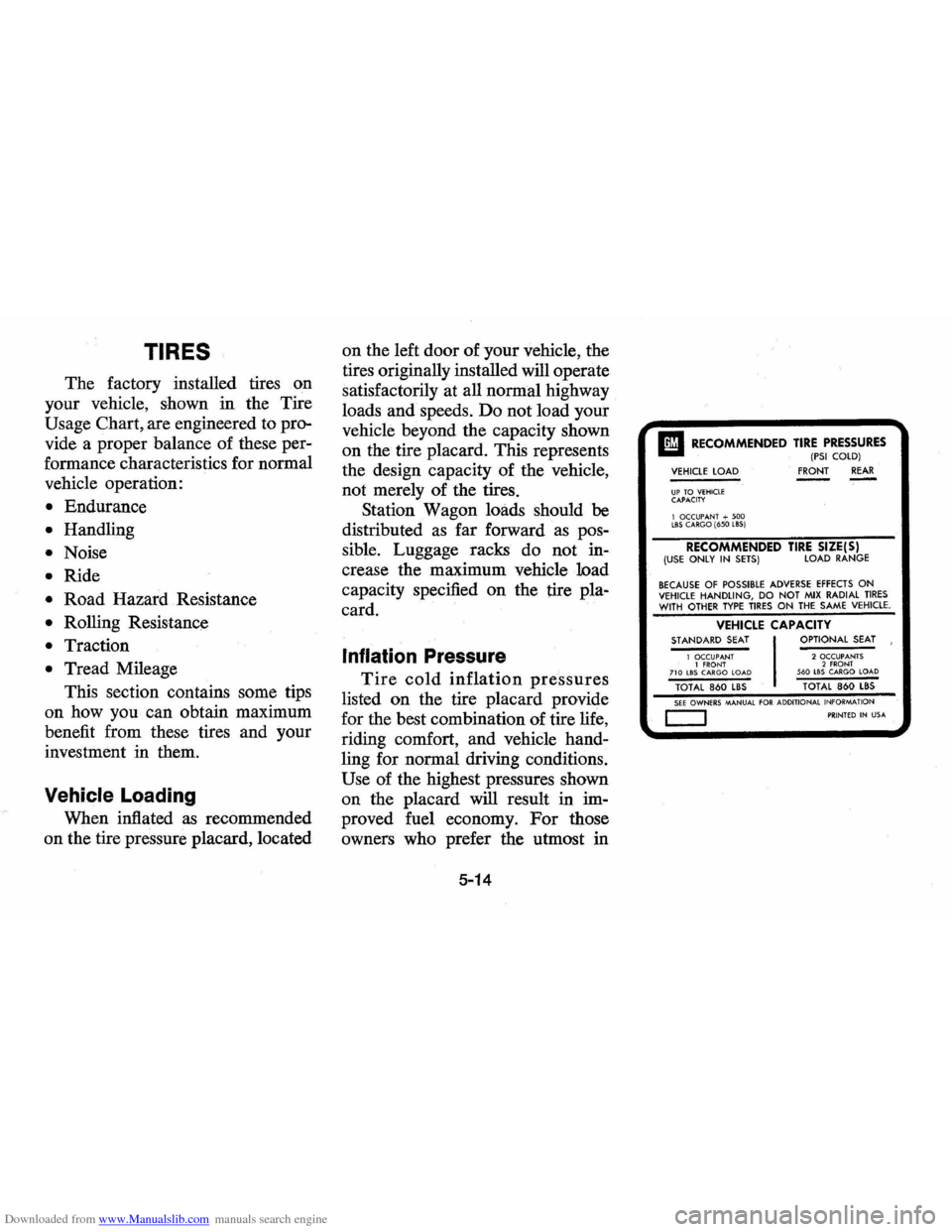
Downloaded from www.Manualslib.com manuals search engine TIRES
The factory installed tires on
your vehicle, shown in the Tire
Usage Chart, are engineered to pro
vide a proper balance of these per
formance characteristics for normal
vehicle operation:
• Endurance
• Handling
• Noise
• Ride
• Road Hazard Resistance
• Rolling Resistance
• Traction
• Tread Mileage
This section contains some tips
on how you can obtain maximum
benefit from these tires and your
investment in them.
Vehicle Loading
When inflated as recommended
on the tire pressure placard, located on
the left door of your vehicle,
the
tires originally installed will operate
satisfactorily at all normal highway
loads and speeds. Do not load your
vehicle beyond the capacity shown
on the tire placard. This represents
the design capacity of the vehicle,
not merely of the tires.
Station Wagon loads should
be
distributed as far forward as pos
sible. Luggage racks do not in
crease the maximum vehicle load
capacity specified on the tire pla
card.
Inflation Pressure
Tire cold inflation pressures
listed on the tire placard provide
for the best combination of tire life,
riding comfort, and vehicle hand
ling for normal driving conditions.
Use of the highest pressures shown
on the placard will result in
im
proved fuel economy. For those
owners who prefer the utmost in
5-14
II RECOMMENDED TIRE PRESSURES (PSI COlD) VEHICLE lOAD FRONT REAR ----UP TO VEHICLE CAPACITY
1 OCCUPANT + 500 lBS CARGO (650 lBS)
RECOMMENDED TIRE SIZE(S) (USE ONLY IN SETS) LOAD RANGE
BECAUSE OF POSSIBLE ADVERSE EFFECTS ON VEHICLE HANDLING, DO NOT MIX RADIAL TIRES WITH OTHER TYPE TIRES ON THE SAME VEHICLE.
VEHICLE CAPACITY STANDARD SEAT OPTIONAL SEAT
1 OCCUPANT 2 OCCUPANTS 1 fRONT 2 FRONT 710 lBS CARGO LOAD 560 LBS CARGO LOAD TOTAL 860 lBS TOTAL 860 lBS SEE OWNERS MANUAL FOR ADDITIONAL
INFORMATION
c::J PRINTED IN USA
Page 73 of 87
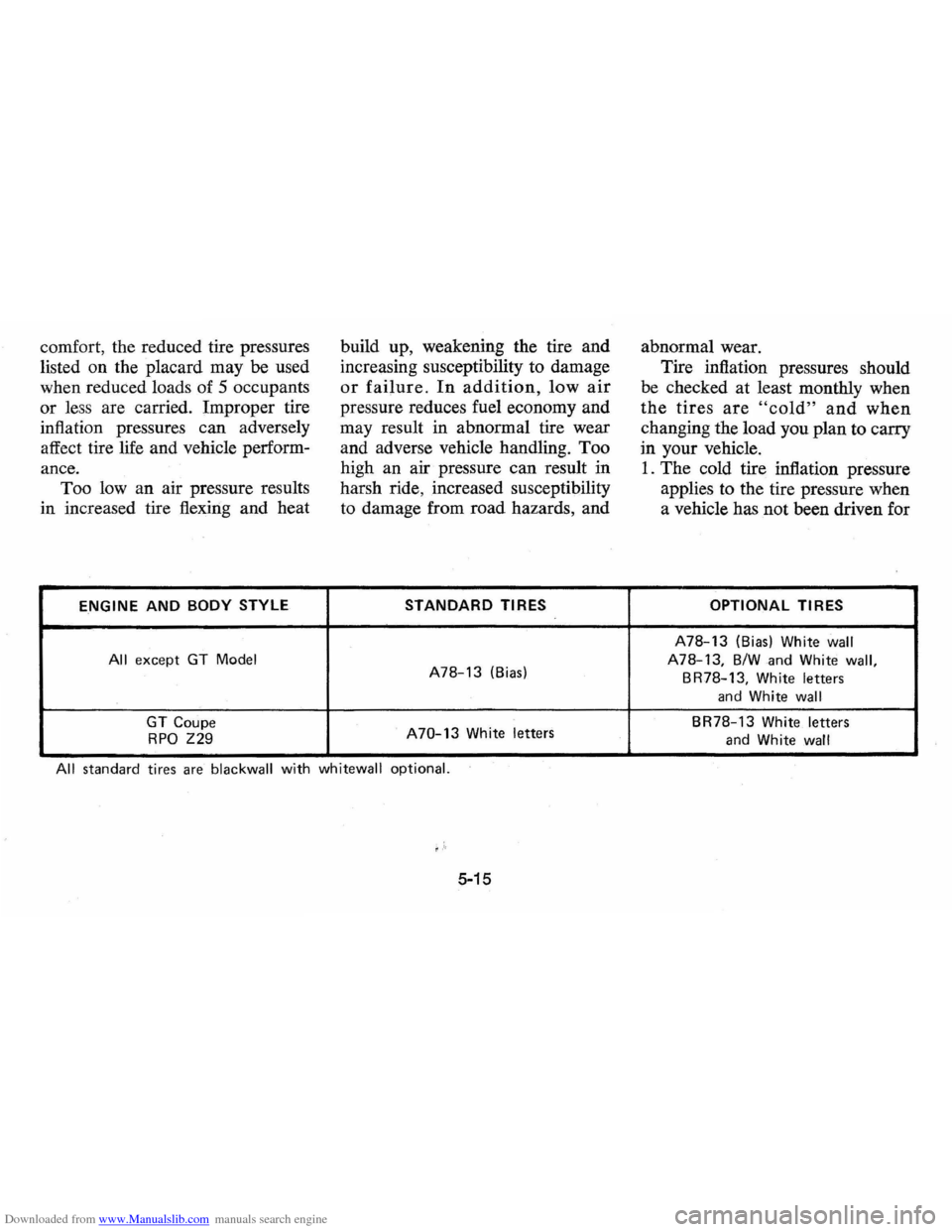
Downloaded from www.Manualslib.com manuals search engine comfort, the reduced tire pressures
listed on the placard may
be used
when reduced loads of 5 occupants
or less are carried. Improper tire
inflation pressures can adversely
affect tire life and vehicle perform
ance. Too
Iowan air pressure results
in increased tire flexing and heat
ENGINE AND BODY STYLE
All except GT Model
GT Coupe
RPO Z29
build up, weakening the tire and
increasing susceptibility to damage
or failure. In addition, low air
pressure reduces fuel economy and
may result in abnormal tire wear
and adverse vehicle handling. Too
high an air pressure can result in
harsh ride, increased susceptibility
to damage from road hazards, and
STANDARD TIRES
A78-13 (Bias)
A70-13 White letters
All standard tires are blackwall with whitewall optional.
f'"
5-15
abnormal wear.
Tire inflation pressures should
be checked at least monthly when
the tires are "cold" and when
changing the load you plan to carry
in your vehicle.
1. The cold tire inflation pressure
applies to the tire pressure when
a vehicle has not been driven for
OPTIONAL TIRES
A78-13 (Bias) White wall
A78-13, B/W and White wall,
BR78-13, White letters
and White wall
BR78-13 White letters
and White wall
Page 74 of 87
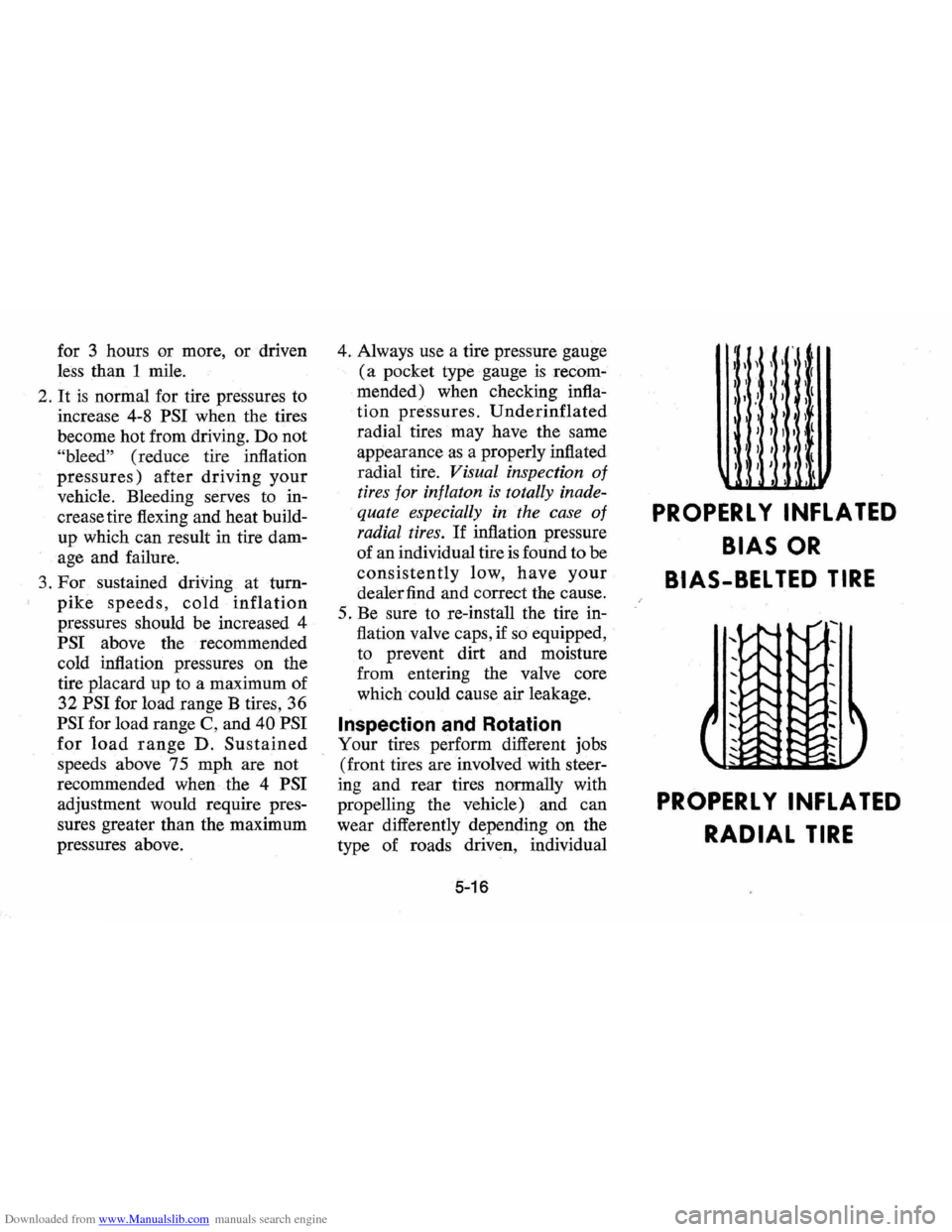
Downloaded from www.Manualslib.com manuals search engine for 3 hours or more, or driven
less than 1 mile.
2 .
It is normal for tire pressures to
increase 4-8
PSI when the tires
become hot from driving. Do not
"bleed" (reduce tire inflation
pressures) after driving your
vehicle. Bleeding serves to in
crease tire flexing and heat build
up which can result in tire dam
age and failure.
3. For sustained driving at turn
pike speeds, cold inflation
pressures should be increased 4
PSI above the recommended
cold inflation pressures on the
tire placard up to a maximum of
32
PSI for load range Btires, 36
PSI for load range C, and 40 PSI
for load range D. Sustained
speeds above 75 mph are not
recommended when the 4
PSI
adjustment would require pres
sures greater than the maximum
pressures above.
4. Always use a tire pressure gauge
(a pocket type gauge is recom
mended) when checking
infla~
tion pressures. Underinflated
radial tires may have the same
appearance
as a properly inflated
radial tire.
Visual inspection of
tires for inflaton is totally inade
quate especially in the case
of
radial tires. If inflation pressure
of an individual tire
is found to be
consistently low, have your
dealer find and correct the cause.
5. Be sure to re-install the tire in
flation valve caps, if
so equipped,
to prevent dirt and moisture
from entering the valve core
which could cause air leakage.
Inspection and Rotation
Your tires perform different jobs
(front tires are involved with steer
ing and rear tires normally with
propelling the vehicle) and can
wear differently depending on the
type of roads driven, individual
5-16
1\ II(
" I I ,t " I' ,I
I' I I j , I I I
I I , I I I I
I I I I I I
I 1
PROPERL Y INFLATED
BIAS OR
BIAS-BEL TED TIRE
PROPERL Y INFLATED
RADIAL TIRE
Page 75 of 87

Downloaded from www.Manualslib.com manuals search engine LF
5 WHEEL ROTATION 4 WHEEL ROTATION
RADIAL TIRES
BIAS PLY TIRE BIAS PLY TIRE 4 WHEEL ROTATION 5 WHEEL ROTATION
BIAS. BELTED TIRES
driving habits, etc. To obtain maxi
mum tire life you should inspect
and rotate your tires regularly.
Many car
and tire dealers will per
form a free tire inspection
and
assist you in identifying uneven
or abnormal tire wear which is
usually the result of incorrect infla
tion pressure, lack
of regular rota
tion, improper wheel alignment,
out-of-1?alance, or poor driving
habits.
Bias
and bias-'belted tires shOUld
be rotated at least every 7,500
miles. Radial tires should be ro
tated at least at the first 7,500 miles
and then at least at 15,000 mile in
tervals thereafter or whenever un
even tire wear is noticed.
Alignment and Balance
Proper front-end alignment mini
mizestire tread wear.
To minimize
tire wear, your front-end suspen
sion
componentS should be in-
5-17
NOTE: It is recommended that the
brakes be inspected for wear when
ever the tires are rotated.
spected regularly.
See the Main~e
nance Schedule folder for more m
formation. Some ball-joints have
built-in wear indicators and some
movement in the joints
is normal.
Improper front -end alignment will
.
not cause vibration. Improper toe
alignment
may cause your. fro~t
tires to drag at an angle resultmg m
excessive wear. Improper camber
alignment may cause your front
tires to wear more
on one side than
on the other and can cause the
vehicle to
"pull" to the left or right.
Proper tire balancing provides
the best riding comfort and helps
to minimize tire tread wear.
Out-of
balance tires can cause annoying
vehicle vibration and irregular tire
wear such
as cupping, fiat spots,
etc.
Page 76 of 87
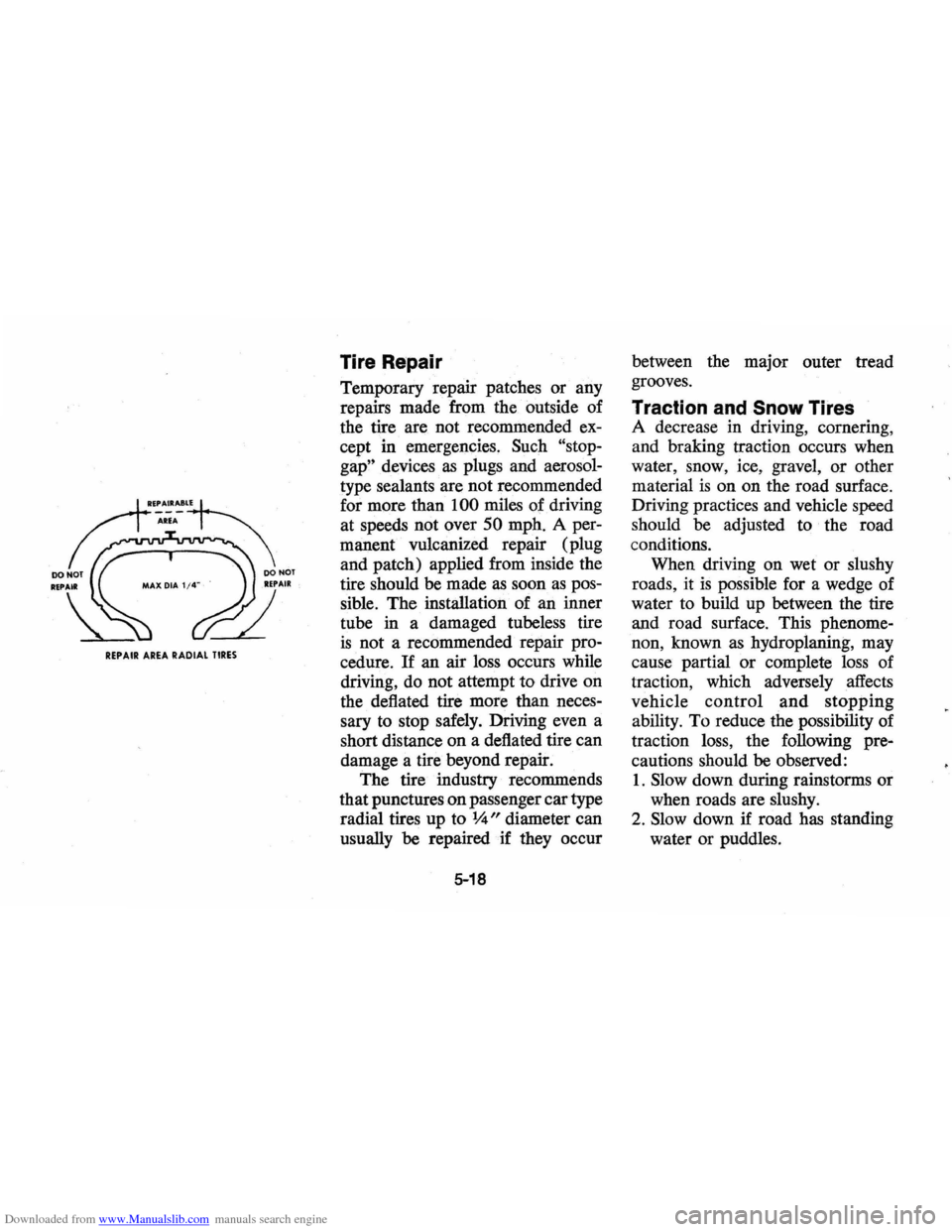
Downloaded from www.Manualslib.com manuals search engine a~~~
DO NOT DO NOT
w~ ~"" "." !d'"
REPAIR AREA RADIAL TIRES
Tire Repair
Temporary repair patches or any
repairs made from the outside of
the tire are not recommended ex
cept in emergencies. Such "stop
gap"
devices as plugs and aerosol
type sealants are not recommended
for more than
100 miles of driving
at speeds not over
50 mph. A per
manent vulcanized repair (plug
and patch) applied from inside the
tire should be made
as soon as pos
sible. The installation of an inner
tube in a damaged tubeless tire
is not a recommended repair pro
cedure.
If an air loss occurs while
driving, do not attempt
to drive on
the deflated tire more than neces
sary to stop safely. Driving even a
short distance on a deflated tire can
damage a tire beyond repair.
The tire industry recommends
that punctures
on passenger car type
radial tires up to
%" diameter can
usually be repaired if they occur
5-18
between the major outer tread
grooves.
Traction and Snow Tires
A decrease in driving, cornering,
and braking traction occurs when
water , snow, ice, gravel,
or other
material
is on on the road surface.
Driving practices and vehicle speed
should be adjusted to the road
conditions. When driving on wet or slushy
roads , it
is possible for a wedge of
water to build up between the tire
and road surface. This phenome
non, known
as hydroplaning, may
cause partial or complete loss of
traction, which adversely affects
vehicle
control and stopping
ability. To reduce the possibility of
traction loss, the following pre
cautions should
be observed:
1 .
Slow down during rainstorms or
when
roads are slushy.
2. Slow down if road has standing
water or
pUddles.
Page 77 of 87
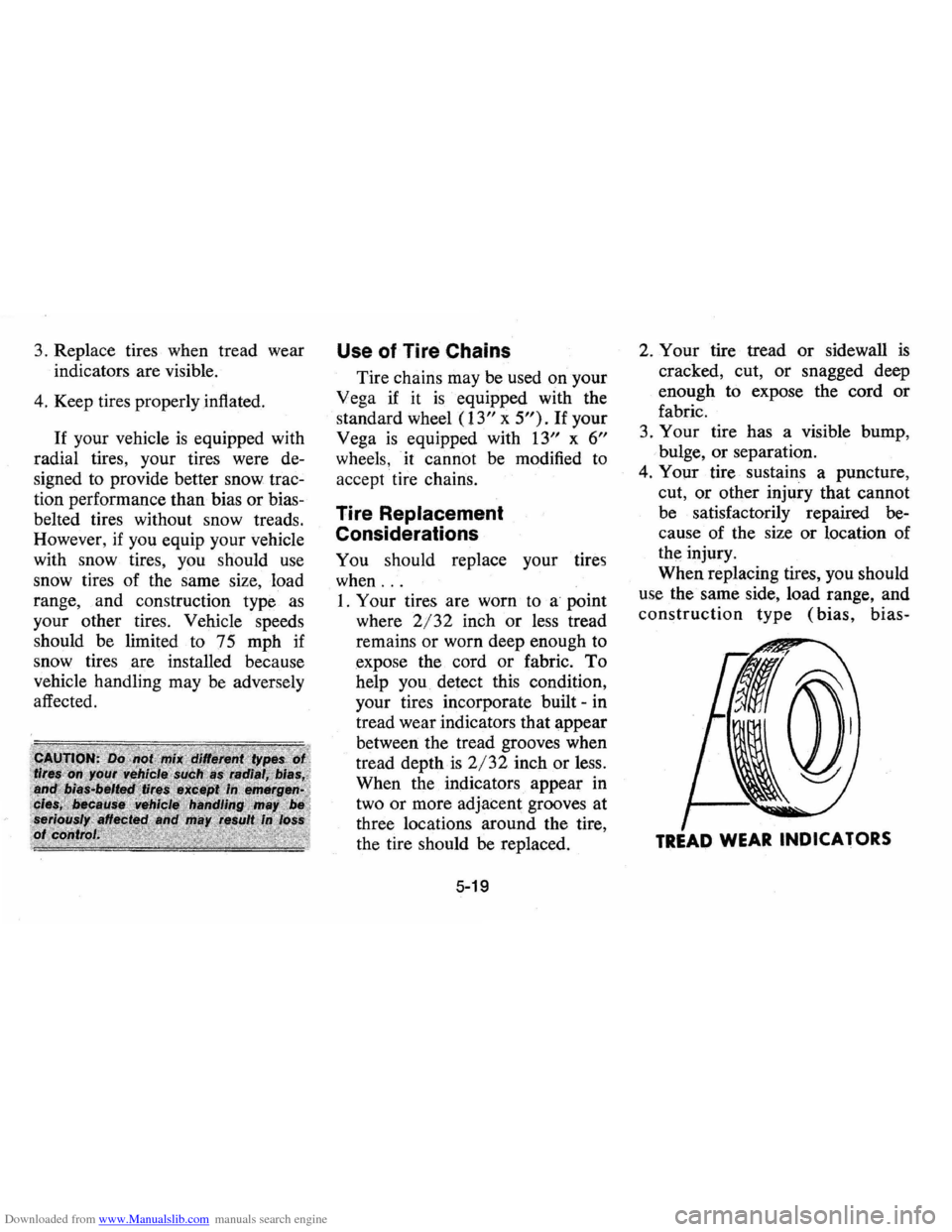
Downloaded from www.Manualslib.com manuals search engine 3. Replace tires when tread wear
indicators are visible.
4. Keep tires properly inflated.
If your vehicle is equipped with
radial tires, your tires were de
signed to provide better snow trac
tion performance than bias
or bias
belted tires without snow treads.
However,
if you equip your vehicle
with snow tires, you should
use
snow tires of the same size, load
range, and construction type
as
your other tires. Vehicle speeds
should be limited to 75 mph if
snow tires are installed because
vehicle handling may
be adversely
affected.
Use of Tire Chains
Tire chains may be used on your
Vega if it
is equipped with the
standard wheel
(13" x 5"). If your
Vega
is equipped with 13" x 6"
wheels, it cannot be modified to
accept tire chains.
Tire Replacement
Considerations
You should replace your tires
when
...
1. Your tires are worn to a point
where
2/32 inch or less tread
remains
or worn deep enough to
expose the cord
or fabric. To
help you. detect this condition,
your tires incorporate built -in
tread wear indicators that appear
between the tread grooves when
tread depth
is 2/32 inch or less.
When the indicators appear in
two
or more adjacent grooves at
three locations around the tire,
the tire should
be replaced.
5-19
2. Your tire tread or sidewall is
cracked, cut, or snagged deep
enough to expose the cord
or
fabric .
3. Your tire has a visible bump,
bulge, or separation.
4. Your tire. sustains a puncture,
cut,
or other injury that cannot
be satisfactorily repaired be
cause of the size
or location of
the injury.
When replacing tires, you should
use the same side, load range, and
construction type (bias, bias-
TREAD WEAR INDICA TORS
Page 78 of 87
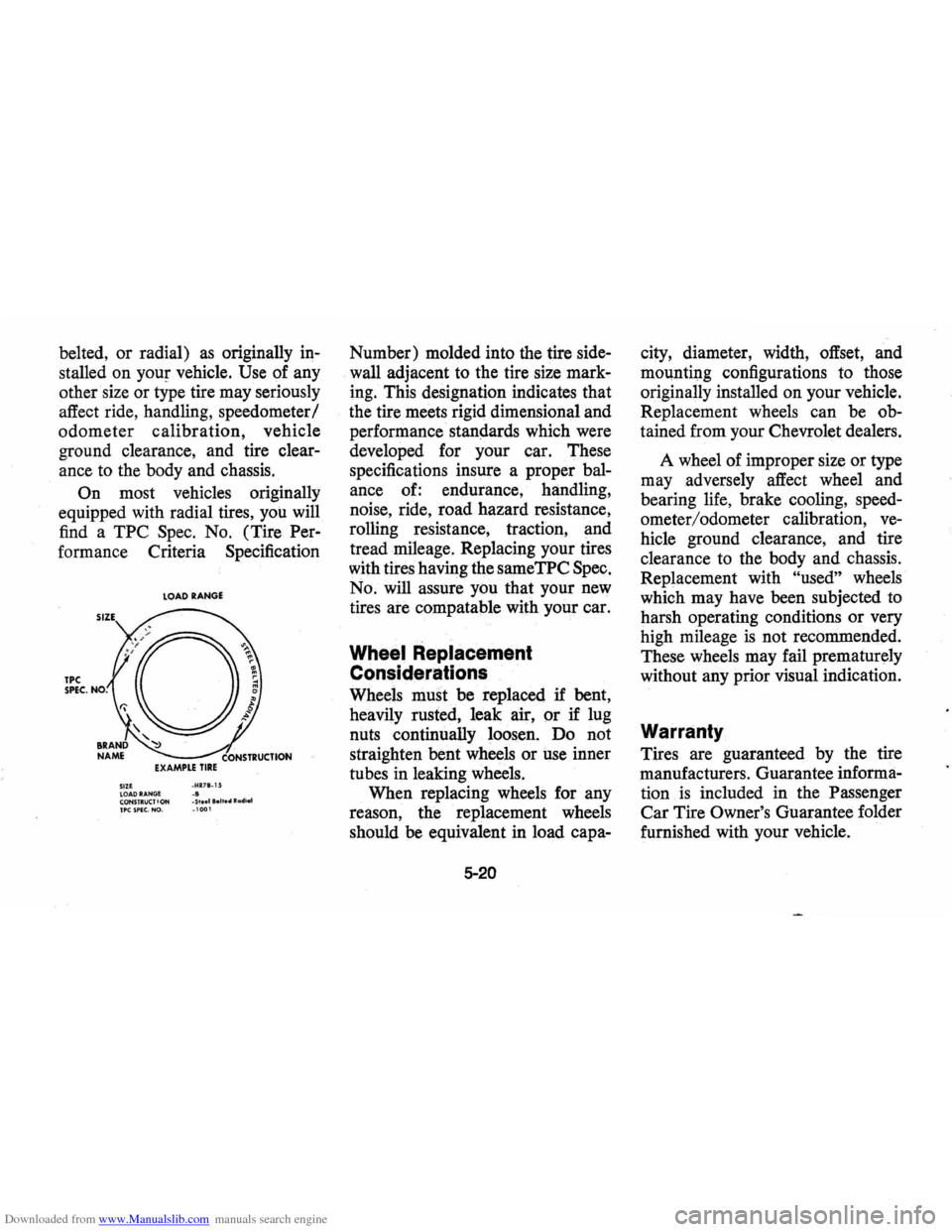
Downloaded from www.Manualslib.com manuals search engine belted, or radial) as originally in
stalled on your vehicle. Use of any
other size
or type tire may seriously
affect ride, handling, speedometer /
odometer calibration, vehicle
ground clearance, and tire clear
ance to the body and chassis.
On most vehicles originally
equipped with radial tires,
you will
find a
TPC Spec. No. (Tire Per
formance Criteria Specification
LOAD RANGE
TPC SPEC. NO.
SItE _HUI_ U LOAD RANG! .8 CONSTRUCT' ON _5, .. 1 a.lt •• Radle.! TPC SPEC. NO. _ 1 00 1
Number) molded into the tire side
wall adjacent to the tire size mark.,.
ing. This designation indicates that
the tire meets rigid dimensional and
performance standards which were
developed for your car. These
specifications insure a proper
bal
ance of: endurance, handling,
noise, ride,
road hazard resistance,
rolling resistance, traction,
and
tread mileage. Replacing your tires
with tires having the sameTPC Spec.
No. will assure you that your new
tires are compatable with your car.
Wheel Replacement
Considerations
Wheels must be replaced if bent,
heavily rusted, leak air,
or if lug
nuts continually loosen.
Do not
straighten
bent wheels or use inner
tubes in leaking wheels.
When replacing wheels for any
reason, the replacement wheels
should
be equivalent in load capa-
5-20
city, diameter, width, offset, and
mOllnting configurations to those
originally installed
on your vehicle.
Replacement wheels
can be ob
tained from your Chevrolet dealers.
A wheel
of improper size or type
may adversely affect wheel and
bearing life, brake cooling, speed
ometer/odometer calibration,
ve
hicle ground clearance, and tire
clearance to the body
and chassis.
Replacement with
"used" wheels
which may have been subjected to
harsh operating conditions
or very
high mileage is
not recommended.
These wheels
may fail prematurely
without any prior visual indication.
Warranty
Tires are guaranteed by the tire
manufacturers. Guarantee informa
tion
is included in the Passenger
Car Tire Owner's Guarantee folder
furnished with your vehicle.
Page 79 of 87
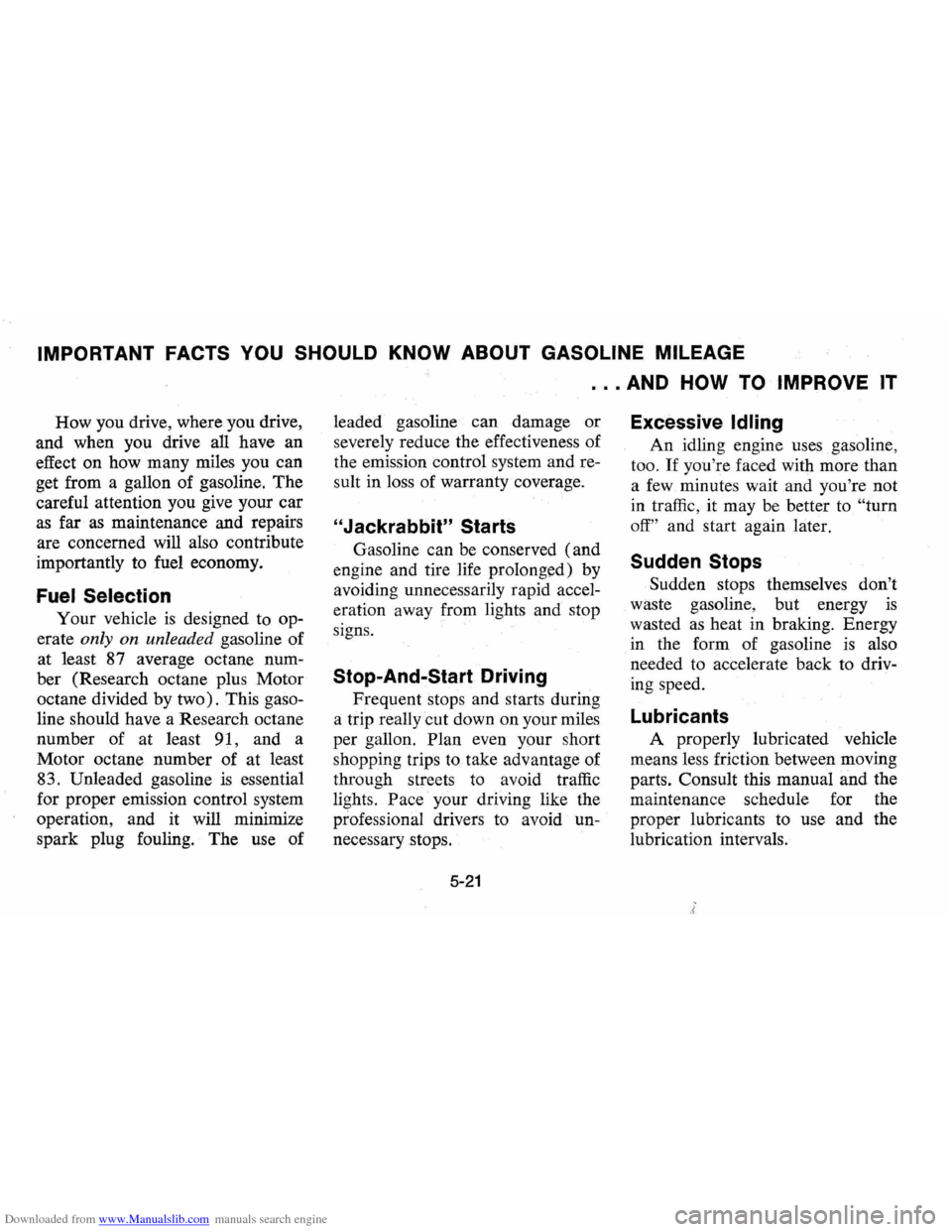
Downloaded from www.Manualslib.com manuals search engine IMPORTANT FACTS YOU SHOULD KNOW ABOUT GASOLINE MILEAGE
How you drive, where you drive,
and when you drive all have an
effect on how many miles you can
get from a gallon of gasoline. The
careful attention you give your car
as far as maintenance and repairs
are concerned will also contribute
importantly to fuel economy.
Fuel Selection
Your vehicle is designed to op
erate
only on unleaded gasoline of
at least 87 average octane num
ber (Research octane plus Motor
octane divided by two). This gaso
line should have a Research octane
number of at least 91, and a
Motor octane number of
at least
83. Unleaded gasoline
is essential
for proper emission control system
operation, and it will minimize
spark plug fouling. The use of
... AND HOW TO IMPROVE IT
leaded gasoline can damage or
severely reduce the effectiveness of
the emission control system and re
sult in loss of warranty coverage.
"Jackrabbit" Starts
Gasoline can be conserved (and
engine and tire life prolonged) by
avoiding unnecessarily rapid accel
eration away from lights and stop
signs.
Stop-And-Start Driving
Frequent stops and starts during
a trip really cut down on your miles
per gallon.
Plan even your short
shopping trips to take advantage of
through streets to avoid traffic
lights.
Pace your driving like the
professional drivers to avoid
un
necessary stops.
5-21
Excessive Idling
An idling engine uses gasoline,
too.
If you're faced with more than
a
few minutes wait and you're not
in traffic, it may be better to
"turn
off"
and start again later.
Sudden Stops
Sudden stops themselves don't
waste gasoline , but energy
is
wasted as heat in braking . Energy
in the form of gasoline
is also
needed to accelerate back to driv
ing speed.
Lubricants
A properly lubricated vehicle
means less friction between moving
parts. Consult this manual and the
maintenance schedule for the
proper lubricants to use and the
lubrication intervals.
Page 80 of 87
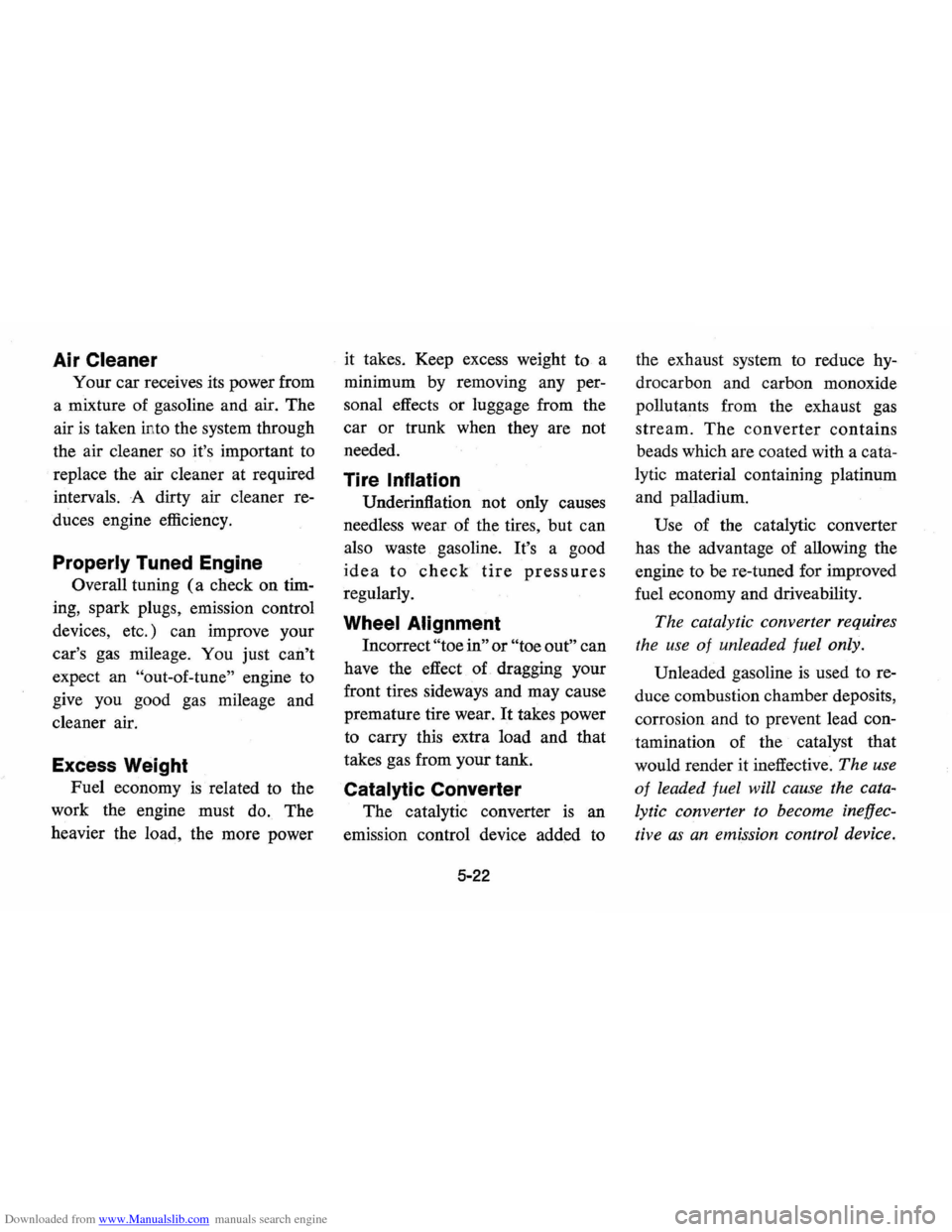
Downloaded from www.Manualslib.com manuals search engine Air Cleaner
Your car receives its power from
a mixture of gasoline and air. The
air
is taken in to the system through
the air cleaner
so it's important to
replace the air cleaner at required
intervals. A dirty air cleaner re
duces engine efficiency.
Properly Tuned Engine
Overall tuning (a check on tim
ing, spark plugs, emission control
devices, etc.) can improve your
car's gas mileage. You just can't
expect an
"out-of-tune" engine to
give you good gas mileage and
cleaner air.
Excess Weight
Fuel economy is related to the
work the engine must do. The
heavier the load, the more power it
takes. Keep excess weight to a
minimum by removing any per
sonal effects or luggage from the
car or trunk when they are not
needed.
Tire Inflation
Underinfiation not only causes
needless wear of the tires, but can
also waste gasoline. It's a good
idea to check tire pressures
regularly.
Wheel Alignment
Incorrect "toe in" or "toe out" can
have the effect
of dragging your
front tires sideways and may cause
premature tire wear.
It takes power
to carry this extra load and that
takes gas from your tank.
Catalytic Converter
The catalytic converter IS an
emission control device added to
5-22
the exhaust system to reduce hy
drocarbon and carbon monoxide
pollutants from the exhaust gas
stream.
The converter contains
beads which are coated with a cata
lytic material containing platinum
and palladium.
Use of the catalytic converter
has the advantage of allowing the
engine to be re-tuned for improved
fuel economy and driveability.
The catalytic converter requires
the use
of unleaded fuel only.
Unleaded gasoline is used to re
duce combustion chamber deposits,
corrosion and
to prevent lead con
tamination of the catalyst that
would render it ineffective.
The use
of leaded fuel will cause the cata
lytic converter to
become ineffec
tive as an emission control device.